Reviews
The Medici Were History’s Greatest Patrons—and Also Tyrants. The Met’s New Show Tackles How Art Served Power
Bronzino is the star of "The Medici: Portraits and Politics"—while Michelangelo sits in judgement somewhere in the background.
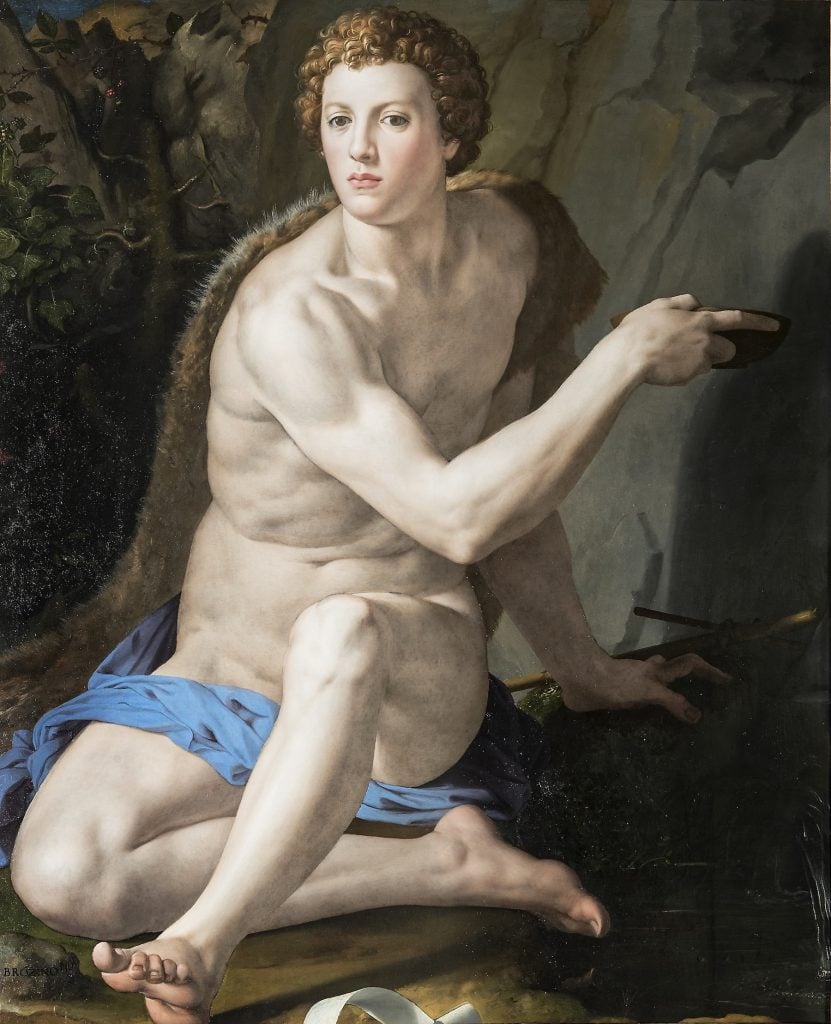
Bronzino is the star of "The Medici: Portraits and Politics"—while Michelangelo sits in judgement somewhere in the background.

Eleanor Heartney

Portrait paintings are sometimes described as windows into the soul. The Renaissance likenesses presented in the Metropolitan Museum’s “The Medici: Portraits and Politics, 1512–1570” have other purposes. Their cold, opulent beauty is more akin to the calculated image curation typical of modern day influencers than to the revelation of character that permeates the paintings of the Met’s nearby Alice Neel exhibition. And that, it seems, is the point of this fascinating exhibition.
This is not the High Renaissance of the celebrated Lorenzo de Medici whose patronage brought us masterpieces by Michelangelo, Botticelli, and Leonardo da Vinci. The exhibition focuses on the later 16th century rule of Florence by Cosimo I de’ Medici and introduces the cast of Mannerist painters who helped him craft his image as the city-state’s benevolent dictator.
Organized by the Met’s Keith Christiansen and Florentine professor Carlo Falciani, the exhibition is laid out in thematic sections that tell the rollicking tale of Cosimo’s rise to power and consolidation of authority through the artworks that helped make it possible.
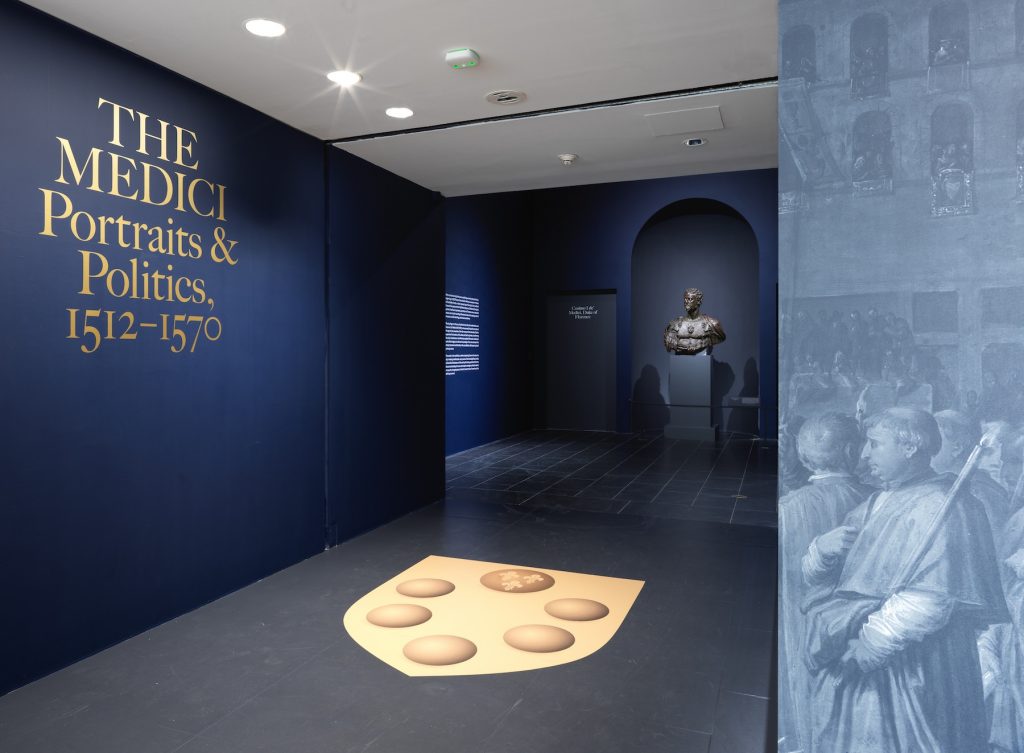
Installation view of “The Medici: Portraits and Politics, 1512–1570” at The Metropolitan Museum of Art, New York. Photo by Hyla Skopitz, Courtesy of The Metropolitan Museum of Art.
The story begins with the machinations that brought the Medicis back to power in Florence after the reestablishment of Republican rule following their expulsion in 1494.
For forty years, Florentine Republicans had mostly held off the onslaught of the Medician autocrats through periods of civil war, plague, and siege. A potent symbol of this struggle was Michelangelo’s David. Installed in 1504 outside the Palazzo Vecchio, the seat of Florence’s civic government, the figure’s stern resolve and youthful vitality provided inspiration for the city’s anti-Medici partisans.
The second coming of the Medici was aided by a pair of Medici Popes: Leo X, a hedonistic pontiff who bankrupted the Vatican with dynastic wars and personal luxuries, and the inept Clement VII who brought on the Sack of Rome and lost half the Church to the Reformation. However otherwise disastrous their reigns, they secured the return of the Medicis to Florence.
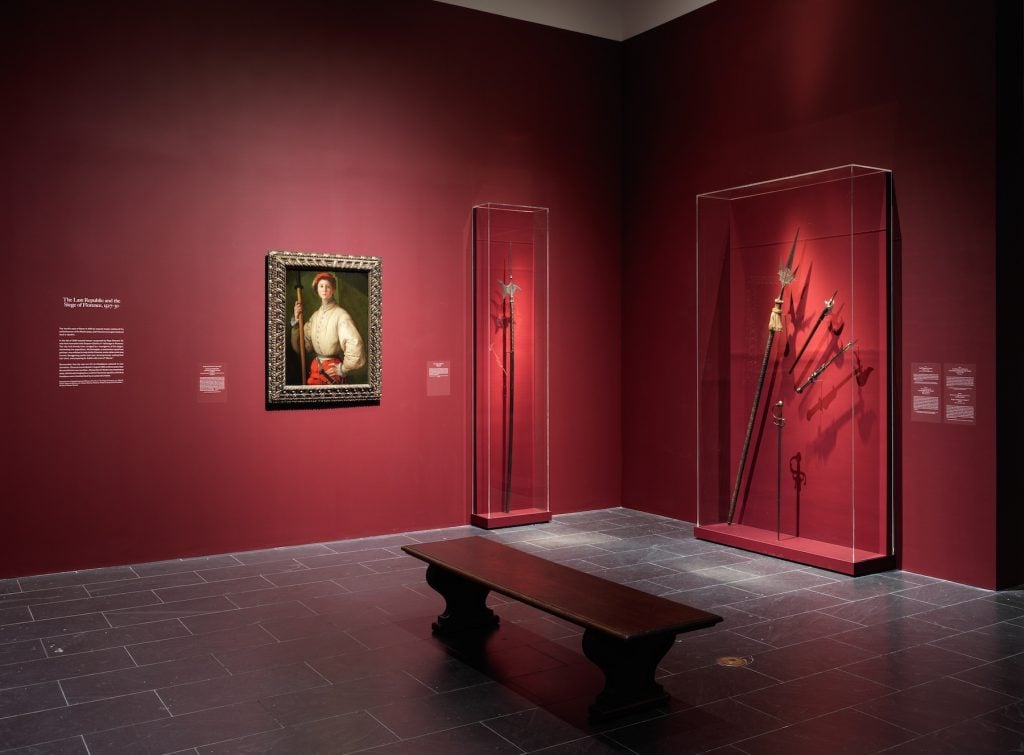
Jacopo da Pontormo, Portrait of a Halberdier (probably Francesco Guardi) (ca. 1528–30) with a display of arms in “The Medici” at the Metropolitan Museum of Art. Photo by Hyla Skopitz, Courtesy of The Met
A series of skirmishes between Republicans and Medici supporters culminated in the 1529 siege of Florence which was led by Clement’s ally the Holy Roman Emperor Charles V. Following the city’s capitulation, Clement installed Alessandro de’ Medici as Duke. The licentious Alessandro, who may have been Clement’s illegitimate son, did not last long. He riled the city’s Republican families and was assassinated by a distant cousin in 1537 in what was celebrated as an act of tyrannicide.
Thanks to wars, murders, and early deaths of designated heirs, Florence was now running out of direct descendants of the original Medici family. As a result, the Dukedom passed to seventeen-year-old Cosimo de Medici, a descendent of a lesser branch of the family. Expected to be a weak leader destined for exile, assassination, or domination by stronger factions, he ruled Florence for over thirty years, established a Medici dynasty that lasted for two centuries and transformed Florence with art patronage and massive public works into the city we know today.
Although “The Medici: Portraits and Politics” includes works by such luminaries as Jacopo Pontormo, Rosso Fiorentino, Benvenuto Cellini, Giorgio Vasari, and Francesco Salviati, the real stars of this exhibition are Cosimo and his favored artist Agnolo Bronzino.
Bronzino was perfectly in tune with his patron. In numerous portraits he depicts Cosimo in a variety of guises: a young warrior in full armor whose hands caress his helmet; an older man of forty, now bearded and dressed in somber black as befitting the statesman he has become; and in an allegorical painting as Orpheus, naked from the back as he turns toward the viewer.
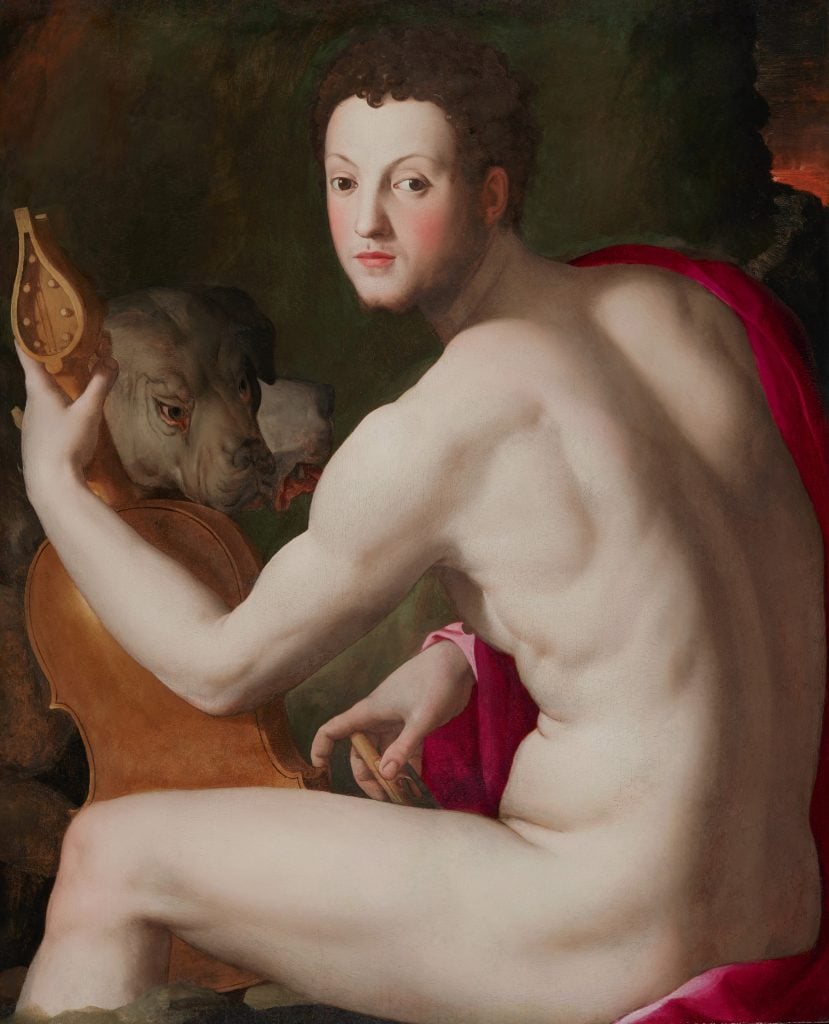
Bronzino, Florence Cosimo I de’ Medici as Orpheus (1537–39). Philadelphia Museum of Art; Gift of Mrs. John Wintersteen, 1950. Image: Courtesy Philadelphia Museum of Art.
In all these depictions, Cosimo offers the same gaze, mask-like in its impenetrability, presenting a picture of steadfast purpose and icy control. This essential message became part of Cosimo’s cultural diplomacy. The non-allegorical portrayals were repainted multiple times and distributed as gifts to friends and potential allies.
Bronzino’s portraits offer a similar treatment of Cosimo’s family. His impressive wife Eleonora di Toledo was a granddaughter of Lorenzo de Medici and served as his frequent political advisor while bearing him eleven children. She is seen here as a gravely modest young wife and as an equally serene mother subtly pregnant as she pushes forward her equally composed young son Francesco.
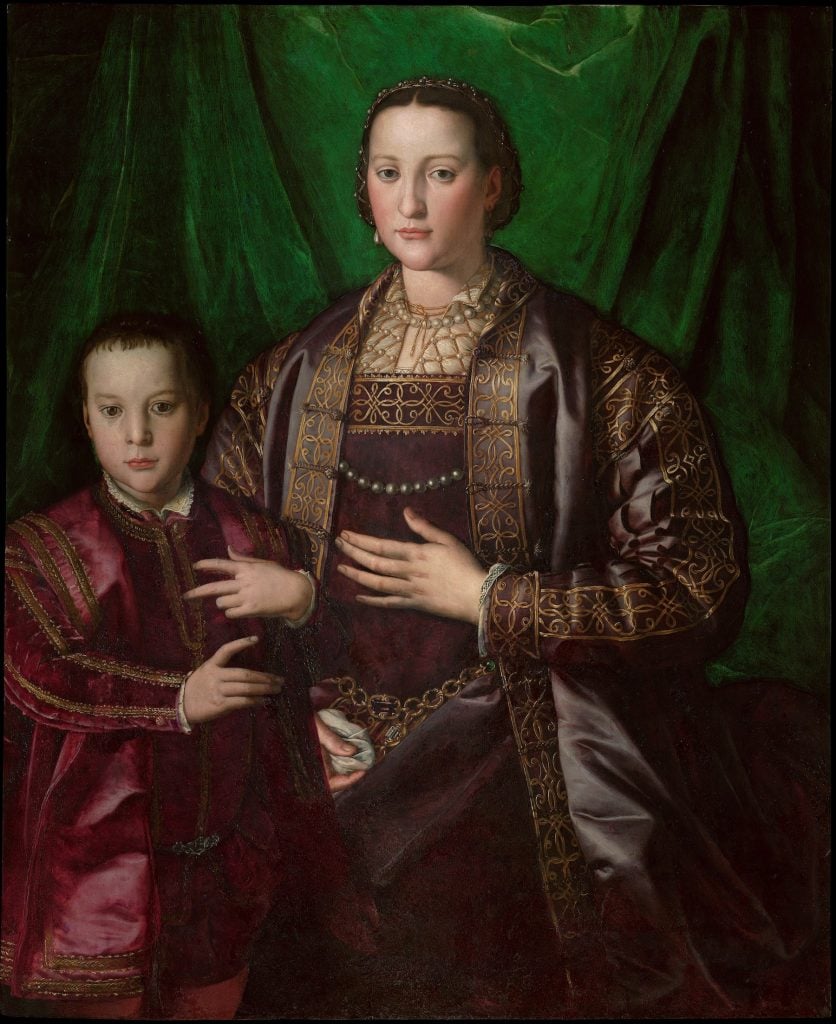
Bronzino, Eleonora di Toledo and Francesco de’ Medici (ca. 1550).
Museo Nazionale di Palazzo Reale, Pisa. Image © Haltadefinizione® Image Bank by permission of the Ministry of Cultural Activities and Heritage—Polo Museale della Toscana.
Francesco reappears elsewhere as a slightly older boy, holding a letter, and, in a 1570 painting by Bronzino’s protégé Alessandro Allori as a young man suited for battle. Francesco would succeed Cosimo as Duke of Florence in 1571, when his father went on to the more august position as the first Grand Duke of Tuscany.
None of Bronzino’s depictions of Cosimo or his family match the fierceness of Cellini’s bust of the Duke. Two versions, one in bronze and one in marble, introduce the exhibition. They present Cosimo as a supremely confident military man swathed in armor ornamented with classical motifs.
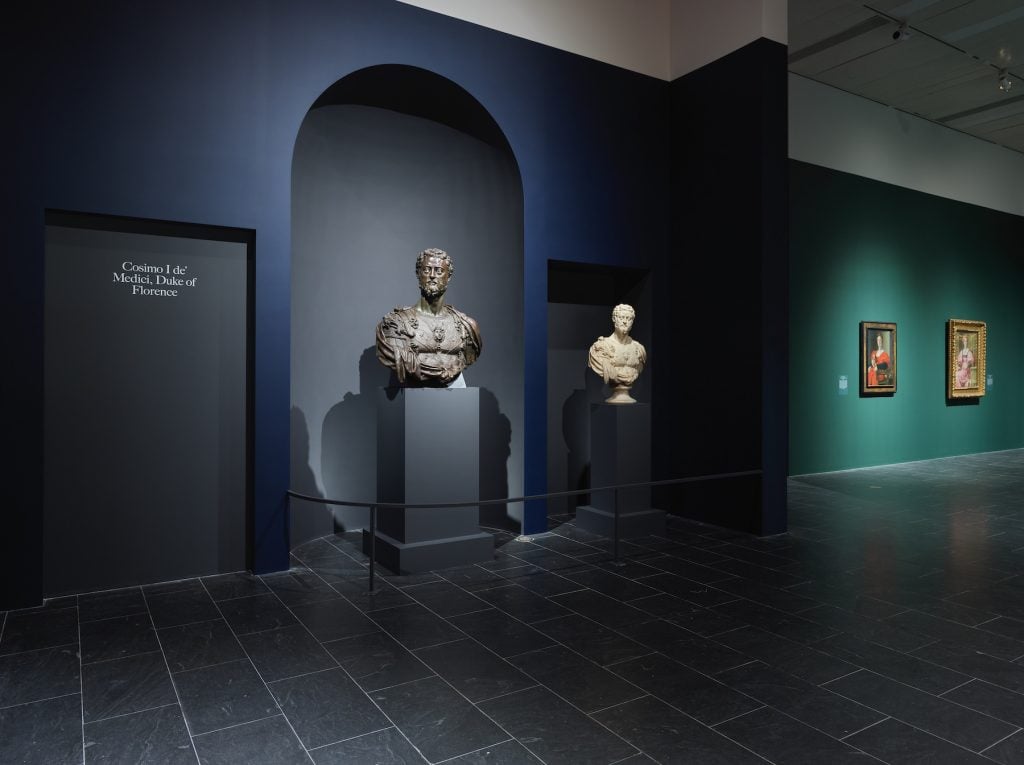
Two portrait busts by Cellini in “The Medici: Portraits and Politics, 1512–1570” at The Metropolitan Museum of Art, New York. Photo by Hyla Skopitz, Courtesy of The Met
This representation was meant to underscore the association of Florence’s 16th century ruler with Rome’s imperious Caesar Augustus. All these official portraits seem designed to smooth over the messy trajectory of Cosimo’s rise to power, his suppression of civil liberties, the political intrigues that marked his reign, and his brutal campaigns against other city-states.
The exhibition includes portraits of other notable figures, both by Bronzino and by other artists. Among these are Francesco Salviati’s probing portrait of Bindo Altoviti, a leading banker and Republican sympathizer; Bronzino’s subtly sexualized depiction of naval commander Andrea Doria as a powerful, nearly naked Neptune; and his tribute to poet Laura Battiferri. The homosexual Bronzino carried on a long platonic relationship with this formidable woman and here depicts her in profile with features that deliberately echo those of a more allegorical painting of Dante he had created thirty years before.
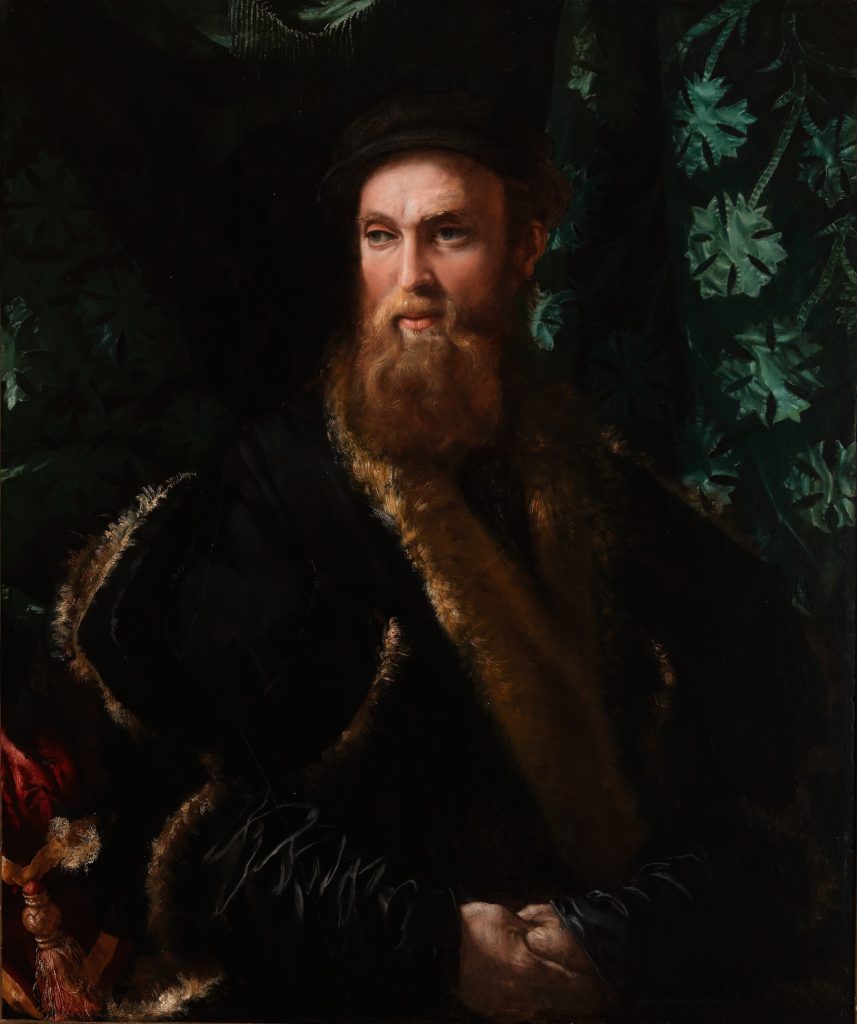
Francesco Salviati, Bindo Altoviti (ca. 1545). Private Collection.
Photograph © Bruce M. White, 2020.
There are as well portraits of some of the more dubious characters in this drama: The ill fated Alessandro de Medici appears in Pontormo’s portrait as a sober, cultured young man captured in the act of sketching the bust of a woman on a piece of paper. Pope Clement VII, painted by Sebastiano del Piombo just before the disastrous Sack of Rome, is a regal figure blissfully unaware of the debacle to come.
The exhibition is dotted with various artifacts. These include rapiers, halberds, and ornamented axes of the sort used by both sides in the siege of Florence, original manuscripts, a red velvet dress that may have been worn by Eleonora di Toledo, and coins that celebrate Cosimo’s architectural projects. These public works were an equally important part of his cultural legacy, dedicated to cementing Florence’s place at the epicenter of Italian Renaissance.
So as to underscore the cool sobriety of Bronzino’s approach, the show ends with a face-off between him and painter Francesco Salviati, a fellow Florentine with more cosmopolitan tastes who had lived in Rome and traveled throughout Italy. Salviati’s portraits, many of them dotted with now obscure mythological motifs, exhibit a warmth and naturalistic approach that make a striking contrast to the chilly perfection of Bronzino’s figures.
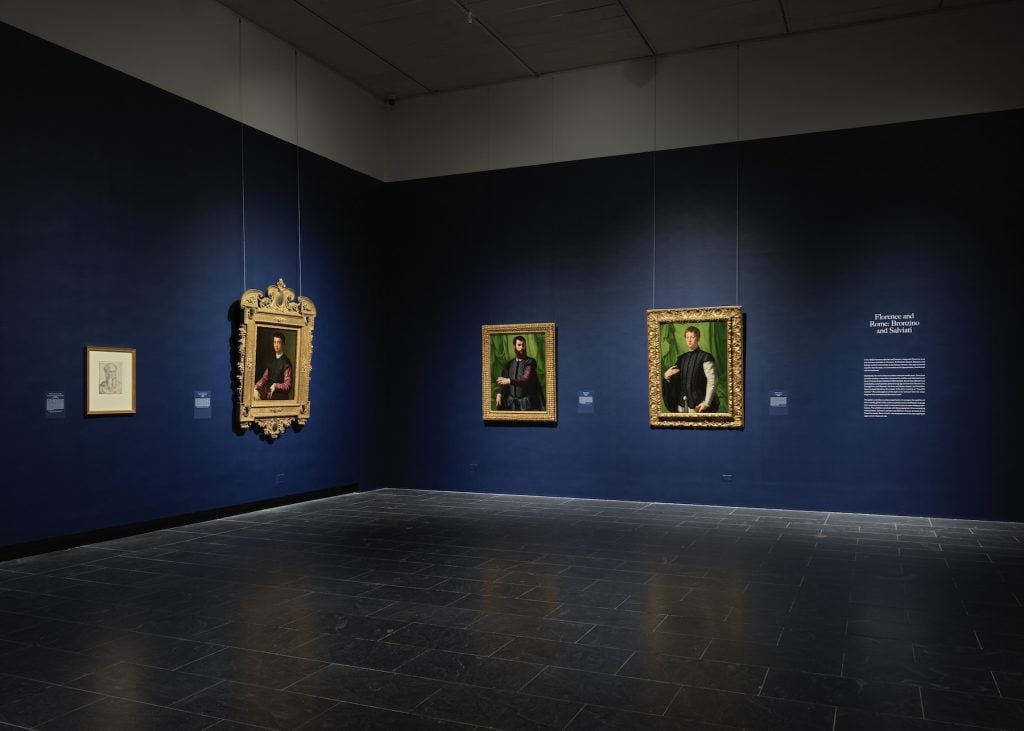
Installation view of the “Florence and Rome: Bronzino and Salviati” gallery in “The Medici: Portraits and Politics, 1512–1570” at The Metropolitan Museum of Art, New York. Photo by Hyla Skopitz, Courtesy of The Metropolitan Museum of Art.
But perhaps a more telling comparison would have been the works of Bronzino and Michelangelo, then and now Florence’s most famous artist. Michelangelo casts a long shadow over the exhibition even though he appears here only in a portrait by Daniele da Volterra. Even unfinished, the work captures its subject’s life force and craggy vitality in a way that seems a rebuke to the flattering elegance of Bronzino’s representations.
Michelangelo posed a problem for Cosimo. Towering above other Florentine artists, he sided with the Republicans in Florence’s civil wars and fled the city forever when Cosimo came to power. Cosimo attempted unsuccessfully to lure him back and only succeeded after Michelangelo’s death, when the old master’s body was returned to Florence and given an extravagant state funeral. With this gesture, Cosimo hoped to tie himself to the revered artist and to obscure Michelangelo’s Republican sympathies. Cosimo had already brought artists of Florence under his patronage through the founding of Florence’s Accademia del Disegno. His embrace of the dead Michelangelo reveals his efforts to control the narrative of history as well.
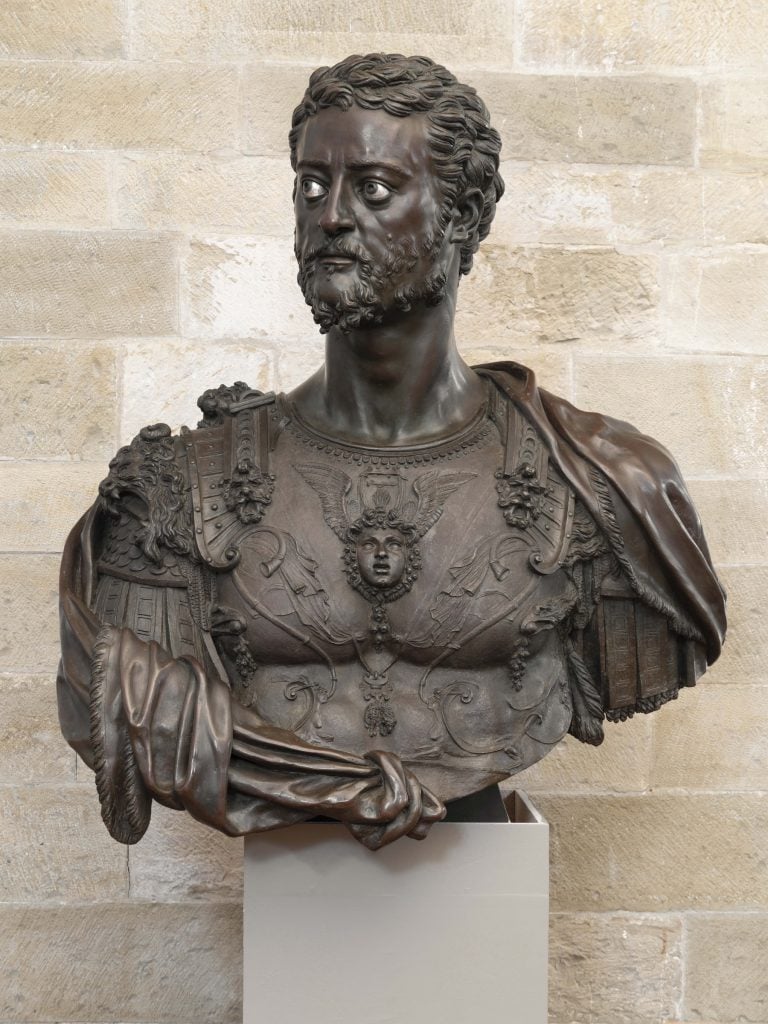
Benvenuto Cellini, Cosimo I de’ Medici (1545). Museo Nazionale del Bargello. By permission of Ministero della Cultura. Photo by Antonio Quattrone.
But in the end, Michelangelo escaped Cosimo’s grasp. His David, now installed in Florence’s Galleria dell’Accademia, is one of the world’s most famous works of art. The generic blandness of Bronzino’s court portraits pale next to the giant slayer’s steely gaze and taut determination. David remains Michelangelo’s compelling monument to the resistance to tyranny.
Is there a lesson here for our so-called Modern Medicis? The art world is currently engaged in an unprecedented inquiry into the political and economic entanglements of museum board members and the ethics of museum patronage. As history reveals, art often finds itself in service to power. But the saga of Cosimo de Medici also suggests there are limits to the control patrons have over the power of art.
“The Medici: Portraits and Politics, 1512–1570” is on view at the Metropolitan Museum of Art, through October 11, 2021.